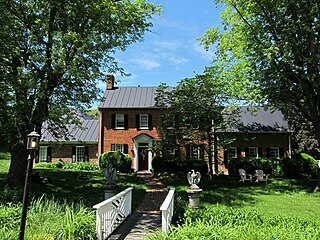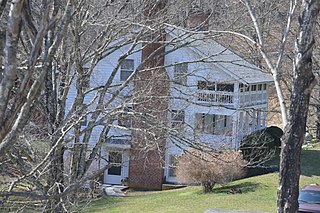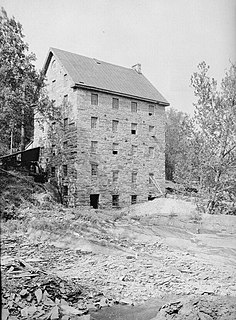
Claytor Lake State Park is a 472-acre (191 ha) state park in Pulaski County, Virginia. The park is located on Claytor Lake, a 4,500-acre (18 km2), 21-mile-long (34 km) reservoir on the New River formed by Claytor Dam, which is used to generate hydroelectric power by the Appalachian Power Company. The reservoir is named for W. Graham Claytor (1886–1971) of nearby Roanoke, a former vice president of Appalachian Power who supervised construction of the dam and creation of the lake.

Ward Charcoal Ovens State Historic Park is an area designated for historic preservation and public recreation located 20 miles (32 km) south of the town of Ely in White Pine County, Nevada. The 700-acre (280 ha) state park protects beehive-shaped charcoal ovens constructed in the latter half of the 19th century.

Pocahontas Exhibition Coal Mine, also known as Pocahontas Mine No. 1, or Baby Mine, is an inactive coal mine in the Pocahontas Coalfield, near Pocahontas in western Virginia. The mine was the first in the sub-bituminous coal of the Pocahontas Coalfield, opening in 1882. In 1938 it became the first exhibition coal mine in the United States. Uniquely, it was possible to drive one's automobile through the mine, entering through the fan opening and exiting through the original entry. The practice continued until 1970, when it was discontinued due to damage to the roof of the mine from car exhaust.

Longdale Furnace is an unincorporated community located east of Clifton Forge in Alleghany County, Virginia, United States.

This is a list of the National Register of Historic Places listings in Albemarle County, Virginia.

This is a list of the National Register of Historic Places listings in Frederick County, Virginia.
This is a list of the National Register of Historic Places listings in Voyageurs National Park.

Clifton Forge Commercial Historic District is a national historic district located at Clifton Forge, Alleghany County, Virginia. The district encompasses 77 contributing buildings in the central business district of Clifton Forge. It primarily includes frame, brick, and concrete block commercial buildings dating to the late-19th and early-20th centuries. The buildings are in a variety of popular architectural styles including Classical Revival, Mission/Spanish Revival, and Italianate. Notable buildings include the Hawkins Brothers Store, Wiley House (1891), Chesapeake and Ohio Office Building (1906), Masonic Theatre (1905), Alleghany Building (1905), Clifton Forge City Hall (1910-1911), U.S. Post Office (1910), Ridge Theatre (1929), the Farrar Building (1930), and the Pure Oil Company Service Station (1932).

Old Forge Farm, also known as Zane's Furnace, Stephens Fort, and Marlboro Iron Works, is a historic home and farm located near Middletown, Frederick County, Virginia. The original section dates to the 18th century. The house is a two-story, asymmetrical, three-bay, limestone dwelling with a two-story addition connecting the main house to a one-story former summer kitchen. Also on the property are the contributing 18th century hexagonal ice house of unusual design, an early 20th-century root cellar, privy, and shed. The property was first known as Stephen's Fort, built by Lewis Stephens, son of Peter Stephens, for protection during the French and Indian War. Sold in 1767 to Isaac Zane, whose Zane's Furnace was a major manufacturer of munitions for the Continental Army. Grist mill operations continued into the 1950s.

Valley Mill Farm, also known as Eddy's Mill, William Helm House, and Helm/Eddy House, is a historic home and farm located near Winchester, Frederick County, Virginia, USA. The house was built about 1820, and is a two-story, four bay, Federal style dwelling with a gable roof. It has a 1 1/2-story wing dated to the mid-19th century. Also on the property are a contributing former two-story mill, a frame two-story tenant house, a storage shed, and the ruins of two small, unidentified buildings.

Brookside Farm and Mill is a historic grist mill and farm complex located at Independence, Grayson County, Virginia. The Brookside Mill was built in 1876, and is a three-story, three bay by three bay, heavy timber frame building measuring 30 feet by 35 feet. The principal dwelling was built in 1877, and is a two-story, three bay, frame building with a central passage plan. Other contributing buildings and structures include a brick spring house, brick smokehouse, log corn crib, frame hen house, miller's cabin, the miller's cottage or Graham House, a frame service station / garage (1918), and concrete dam (1914) and earthen mill race.

Francis–Gulick Mill is a historic archaeological site located near Leesburg, Loudoun County, Virginia. The site includes a small stone miller's house foundation, stone remnants of a mill foundation, and the millrace and two millstones that are lying next to the miller's house foundations. The mill and miller's house may have been built as early as the late-18th century and were in use at least by the second decade of the 19th century. The mill appears to have been abandoned by 1879 and the house was abandoned in the 1880s.

Graves Mill, also known as Jones Mill and Beech Grove Mill, is a historic grist mill complex located near Wolftown, Madison County, Virginia. The complex includes a three-story, heavy timber frame gristmill; a two-story, log, frame, and weatherboard miller's house; and a one-story heavy timber frame barn. The gristmill was built about 1798, probably on the foundation of an earlier gristmill built about 1745. It was owned and operated by members of the Thomas Graves family for more than a century.

Rosegill is a historic plantation house and farm complex located near Urbanna, Middlesex County, Virginia. The house is an 11-bay, two story dwelling with a gable roof. The original section dates to about 1740, and the house was subsequently enlarged and modified to reach its present form about 1850. Another remodeling occurred in the 1940s. Also located on the property are a mid-18th century kitchen and wash house, mid-18th century office, a 19th-century frame smokehouse, and a 19th-century bake oven.

Beverley Mill, also known as Chapman Mill, is a historic grist mill located north of Interstate 66 and Virginia State Route 55 in Thoroughfare Gap near Broad Run, Virginia, straddling the county line between Prince William and Fauquier Counties. It was built about 1759, and is a five-story, four bay by three bay, rubble stone structure. The water power was provided by Broad Run which, in its 1,300-foot (400-metre) passage through the Gap, drops 87 feet. Exterior mill machinery included a 29-foot (8.8-metre) metal waterwheel and sluice gate as well as a stone mill race. The mill continued in operation through World War II. It is included in the Thoroughfare Gap Battlefield.

Buffalo Forge, also known as the Forge Complex, is a historic iron forge complex and national historic district located near Glasgow, Rockbridge County, Virginia. The district encompasses 11 contributing buildings, 1 contributing site, and 3 contributing structures. The manor house is known as Mount Pleasant and was built in two sections of similar stone construction. The earlier section dates to about 1819, and the wing was added about 1830. A frame wing was added in the late-19th century and a kitchen wing in the early-20th century. The district also includes the contributing kitchen, two slave quarters, garage, spring house / dairy, stone cabin (pre-1865), shed (pre-1900), stables / barn (pre-1865), corn crib (pre-1920), hen house (pre-1920), and the ruins of the merchant mill and mill race. Iron production at Buffalo Forge ceased in the fall of 1868.

Breneman-Turner Mill is a historic grist mill located near Harrisonburg, Rockingham County, Virginia. It was built about 1800, and is a 2 1/2-story, Federal style brick building. The building retains its water wheel, measuring 16 feet in diameter and 5 feet wide, and three sets of burr stones. The mill survived General Philip Sheridan’s burning of the Shenandoah Valley in 1864, and remained in operation until 1988.

Jessee’s Mill is a historic grist mill located near Cleveland, Russell County, Virginia. The original section was built about 1850, as a single pen log structure. About 1890, a two-story balloon frame addition was built on top of the old log structure. The mill retains much of its original milling equipment. Also located on the property are the contributing mill dam and a frame barn. The mill remained in operation until 1932.

Causey's Mill is a historic grist mill located in Causey's Mill Park at Newport News, Virginia. It was built in 1866, and is a small two-story wood-frame building originally supported by a brick and concrete foundation. It retains its original machinery and is one of the two last surviving grist mills on the Peninsula. The mill operated until nearly the 20th century. In 2011, the mill was moved about 75 feet from its original location away from the shore of the Mariners' Lake and set on a new foundation.

Lambert's Point Knitting Mill, also known as The Knitting Mill and Old Dominion Paper Company, is a historic mill building located at Norfolk, Virginia. It was built in 1895, and consists of the central two-story original mill building highlighted by a tall four-story tower. It was augmented in the 1950s by a one-story addition on the south elevation, and by additional one-story additions on the north and west sides of the building. The masonry structure is clad with smooth-finished concrete stucco.
























